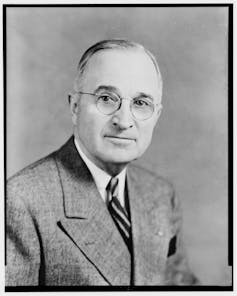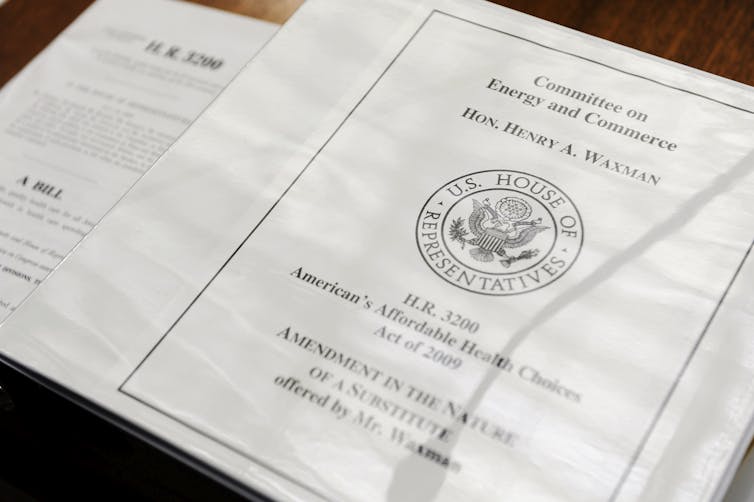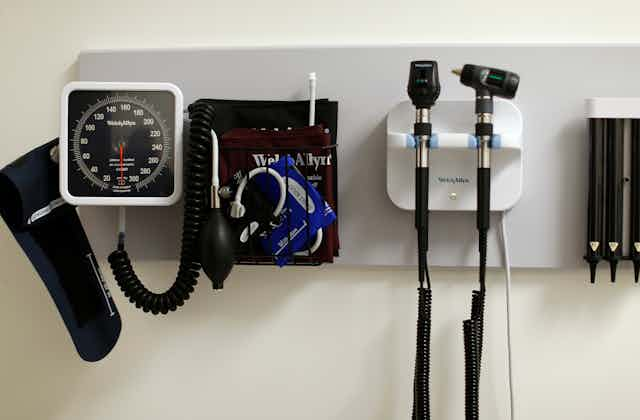It’s that time of year again. Insurance companies that participate in the Affordable Care Act’s state health exchanges are signaling that prices will rise dramatically this fall.
And if insurance costs aren’t enough of a crisis, researchers are highlighting deficiencies in health care quality, such as unnecessary tests and procedures that cause patient harm, medical errors bred by disjointed or fragmented care and disparities in service distribution.
While critics emphasize the ACA’s shortcomings, cost and quality issues have long plagued the U.S. health care system. As my research demonstrates, we have these problems because insurance companies are at the center of the system, where they both finance and manage medical care.
If this system is so flawed, how did we get stuck with it in the first place?
Answer: organized physicians.
As I explain in my book, “Ensuring America’s Health: The Public Creation of the Corporate Health Care System,” from the 1930s through the 1960s, the American Medical Association, the foremost professional organization for physicians, played a leading role in implementing the insurance company model.
What existed before health insurance companies?
Between the 1900s and the 1940s, patients flocked to what were called “prepaid physician groups,” or “prepaid doctor groups.”
Prepaid groups offered inexpensive health care because physicians acted as their own insurers. Patients paid a monthly fee directly to the group rather than to an insurance company. Physicians undermined their financial position if they either oversupplied services (as they do today) or if they rationed services. Ordering unnecessary tests and procedures drained away the group’s resources and adversely affected physician pay, which was often tied to quarterly profits. But if patients were unhappy with their care, the group stood to lose paying patients.

Unlike today’s medical group practices, prepaid groups were composed of doctors from various specialties. So rather than solely working with other general practitioners, GPs worked with surgeons, obstetricians and ophthalmologists. At the end of each day, the group’s physicians met with one another to consult over tricky cases. Thus, chronically sick patients and individuals with several conditions or difficult-to-diagnose illnesses enjoyed one-stop medical care.
Many health care reformers, including those behind President Truman’s failed 1948 universal care proposal, hoped to develop the medical economy around prepaid groups. Progressives believed that by federally funding prepaid groups, they could efficiently supply the entire population with comprehensive care.
Why did the AMA oppose prepaid doctor groups?
As prepaid doctors groups gained in popularity, the AMA took notice and began organizing to combat them.
AMA leaders were afraid that self-insuring, multi-specialty groups would eventually evolve into health care corporations. They feared that this “corporate medicine” would render physicians mere cogs in a bureaucratic hierarchy.
So AMA officials threatened doctors working for or contemplating joining prepaid groups. Because AMA members occupied influential roles in hospitals and on state licensing boards, practitioners who refused to heed their warnings usually lost their hospital admitting privileges and medical licenses. These actions severely weakened existing prepaid groups and prevented physicians from establishing new ones.
But the AMA also vigorously opposed government involvement in health care. While they had great success defeating prepaid doctor groups, AMA leaders realized that that if they continued knocking down private attempts to organize health care, government officials would step in to manage the medical economy. Indeed, throughout the 1930s and 1940s, health care reform was a popular goal for progressive policymakers.
The birth of the insurance company model
In order to build up the private sector as a means for fighting government health care reform, AMA leaders designed the insurance company model.
AMA leaders decided that rather than allowing doctors to insure patients, only insurance companies would be permitted to offer medical coverage.
During the 1930s, insurance companies sold life insurance policies and worked with businesses to provide employee pensions. Insurance company executives had no interest in entering the health care field. But they reluctantly agreed to go along with the AMA plan in order to help physicians defeat nationalized medicine.
AMA officials believed they could keep corporate power separate from medicine by instituting a few rules. First, insurance companies were forbidden from financing multi-specialty physician groups. AMA officials insisted that physicians practice individually or in single-specialty partnerships. Second, the AMA banned the use of set salaries or per-patient fees. They instead required insurance companies to pay doctors for each and every service they supplied (fee-for-service payment). Finally, the AMA prohibited insurance companies from supervising physician work. Physician leaders concluded that these arrangements would protect their earnings and autonomy.
Unfortunately, the insurance company model fragmented care across numerous specialties and encouraged physicians and hospitals to practice without regard for financial resources. With a distant corporation footing the bill, there was little to prevent hospitals and physicians from ordering unessential tests and procedures for insured patients. Many patients with insurance received excessive medical services. Unwarranted surgeries – for example, medically unnecessary appendectomies – became a national crisis by the 1950s, and hospital admission rates increased far beyond what even the most innovative technologies called for.

Medicare adopts the insurance company model
From the 1940s on, the nation’s health care system steadily developed around the faulty insurance company model. Though initially uneasy with one another, physicians and insurers worked together to strengthen and spread insurance company arrangements. They did so to demonstrate that the federal government need not interfere in health care. And their gambit worked: Physicians and insurers defeated attempts under Presidents Truman and Eisenhower to reform health care.
When federal politicians finally did intervene in health care with the passage of Medicare in 1965, the insurance company model had been developing for decades. Government agencies simply could not match the private economy’s organizational capabilities. So, grudgingly, the health care reformers and progressive politicians behind Medicare built their program of government-funded health policies for the elderly around the insurance company model. Medicare’s architects also appointed insurance companies to act as program administrators, to operate as intermediaries between the federal government and hospitals and physicians, a role that they have to this day.
Medicare’s adoption of the insurance company model signaled its complete domination of U.S. health care.
Predictably, health care prices skyrocketed. Even before Medicare’s passage, politicians, journalists, and academics had been debating what to do about rising health care costs. Then Medicare brought millions of new elderly – and more sickly – patients into the system. Consequently, from 1966 through 1973, health care spending increased approximately 12 percent each year. Today, U.S. medical care expenditures are the highest in the world, making up 18 percent of the nation’s gross domestic product.
To control prices, insurers have gradually, over the course of many decades, implemented cost containment measures. These measures have required doctors to report their actions to insurers and increasingly seek insurer permission to perform medical services and procedures.
Insurers, once forbidden from supervising physician work, now act as managers, peering over the shoulders of doctors in a vain effort to counteract payment incentives that have created an oversupply of insured care.

Insurance companies maintain their position in the ACA
While the flaws of the insurance company model have become more evident, reforming the system has proven extremely difficult. Just look at the Affordable Care Act.
ACA planners attempted to undermine the insurance company model by proposing a public option – government-managed insurance that officials could deck out with generous benefits while subsidizing coverage to hold down policy prices. This strategy would allow the public option to outcompete and eventually destroy existing private-sector coverage. Opponents, including the AMA, viewed it as a step toward a government takeover of health care. Amid the intense political fighting, the public option was dropped, and the ACA was built around the insurance company model.
Thus, since the ACA’s passage, premium prices have continued to climb and deductibles have increased. Insurers have scaled back the number of physicians and hospitals in their networks. At the same time, researchers question health care quality and service disparities.
Looking to the future
Reacting to voters’ frustration with this news, both presidential candidates have called for additional health care reforms. Reforms based on prepaid doctor groups hold the potential for bipartisan support.
Hillary Clinton is calling for a public option, which, if passed, would weaken the power of insurance companies. Clinton could use such a policy to reboot the prepaid group model.
Donald Trump advocates the repeal of the ACA and the sale of insurance across state lines. Republicans, citing fealty to market competition and consumer choice, could also rally around prepaid doctor groups.
With growing patient dissatisfaction and concern among physicians about insurance company dominance, prepaid groups could finally succeed.

